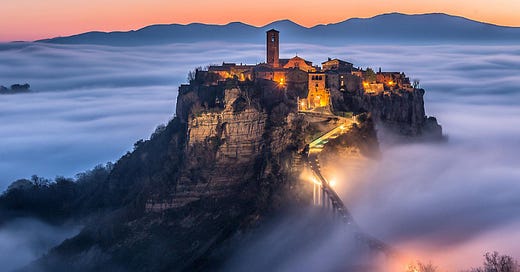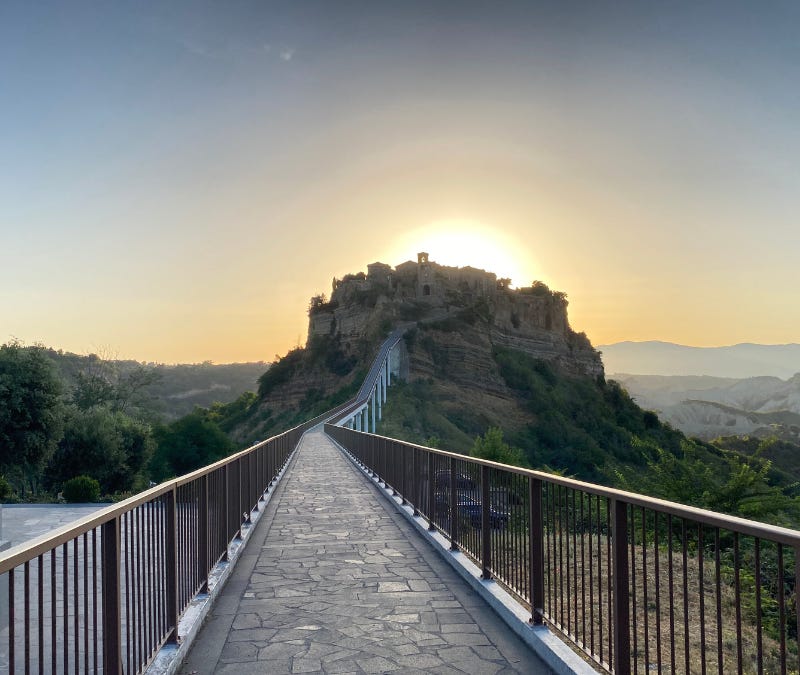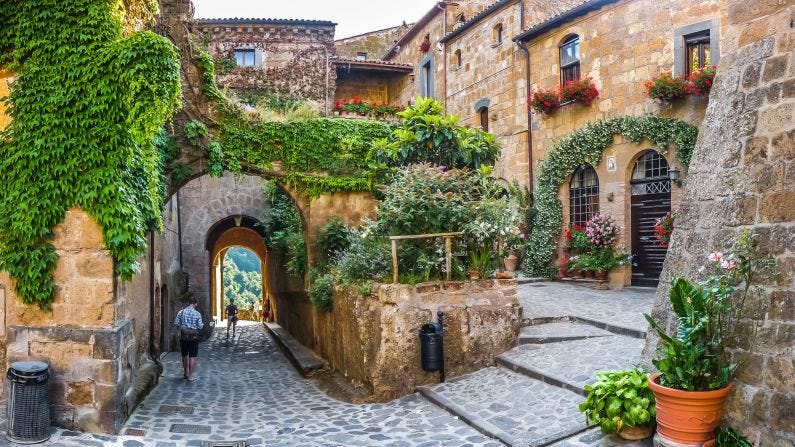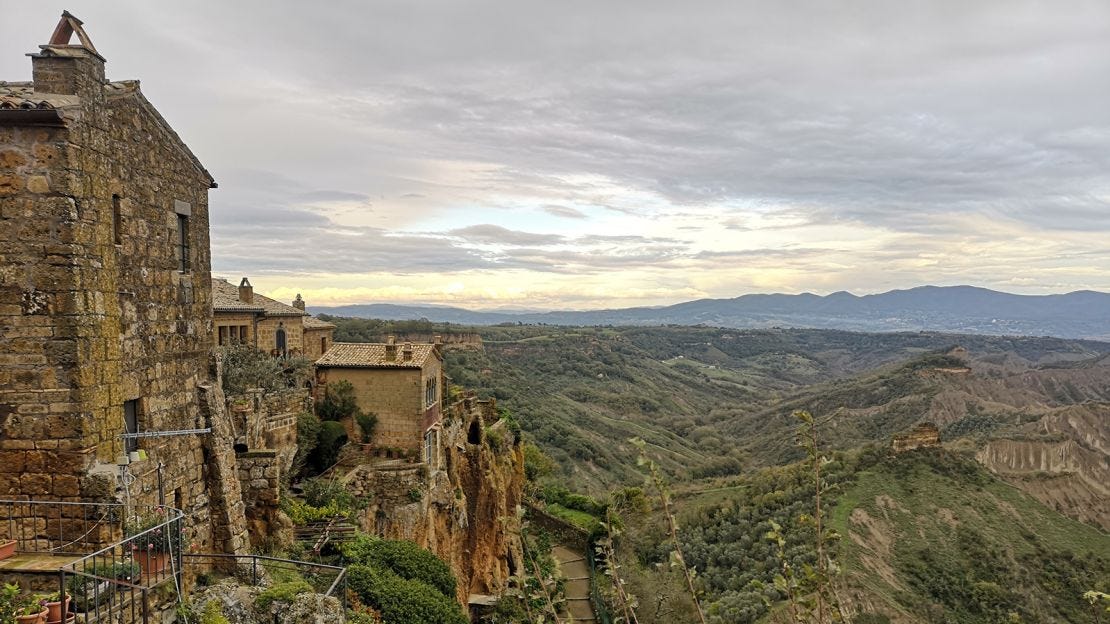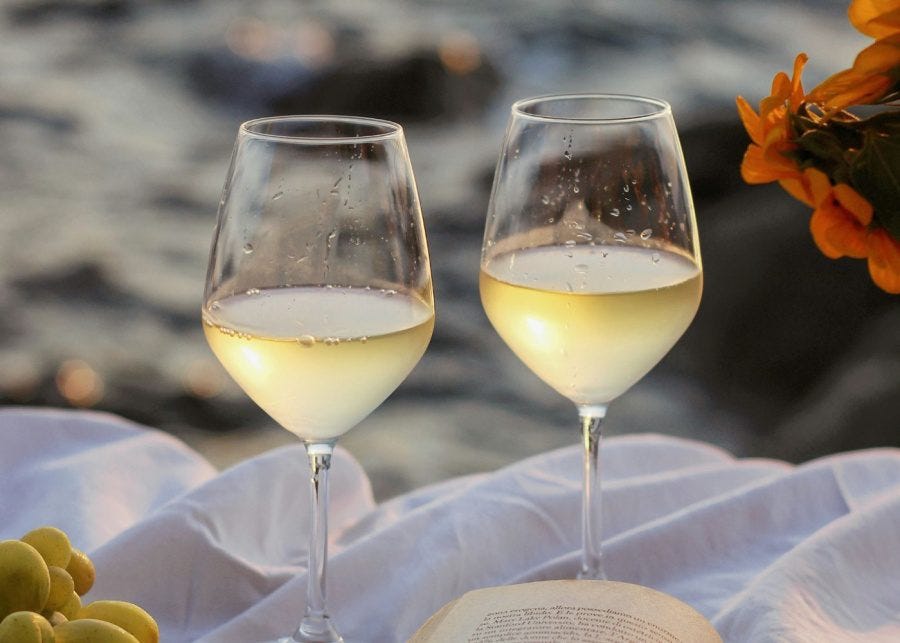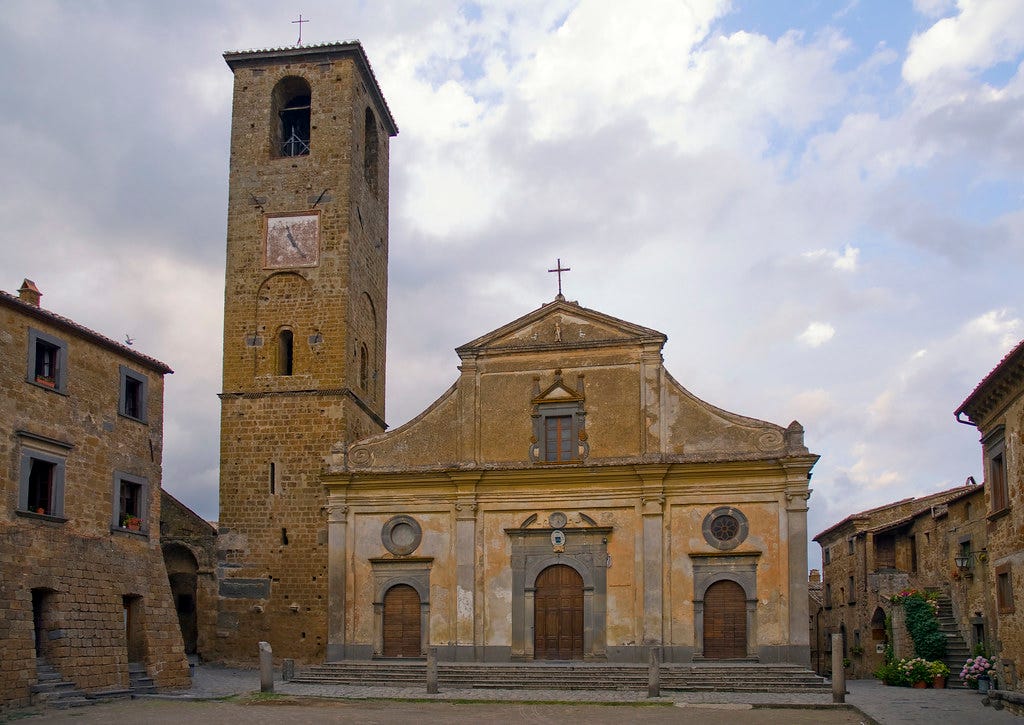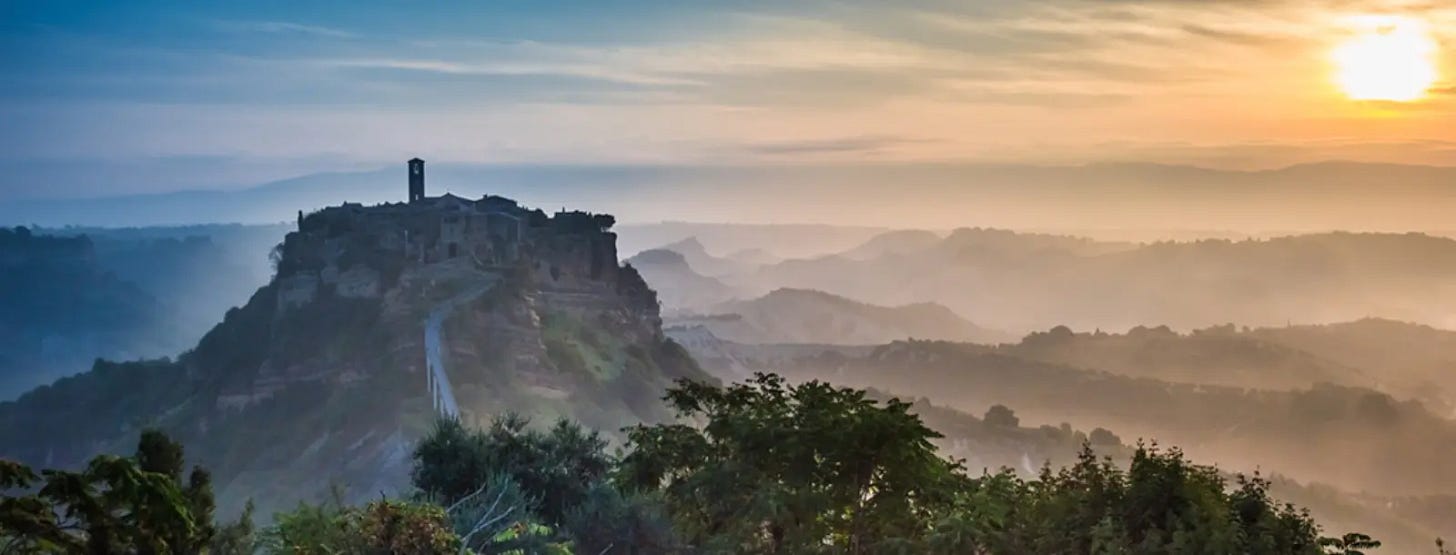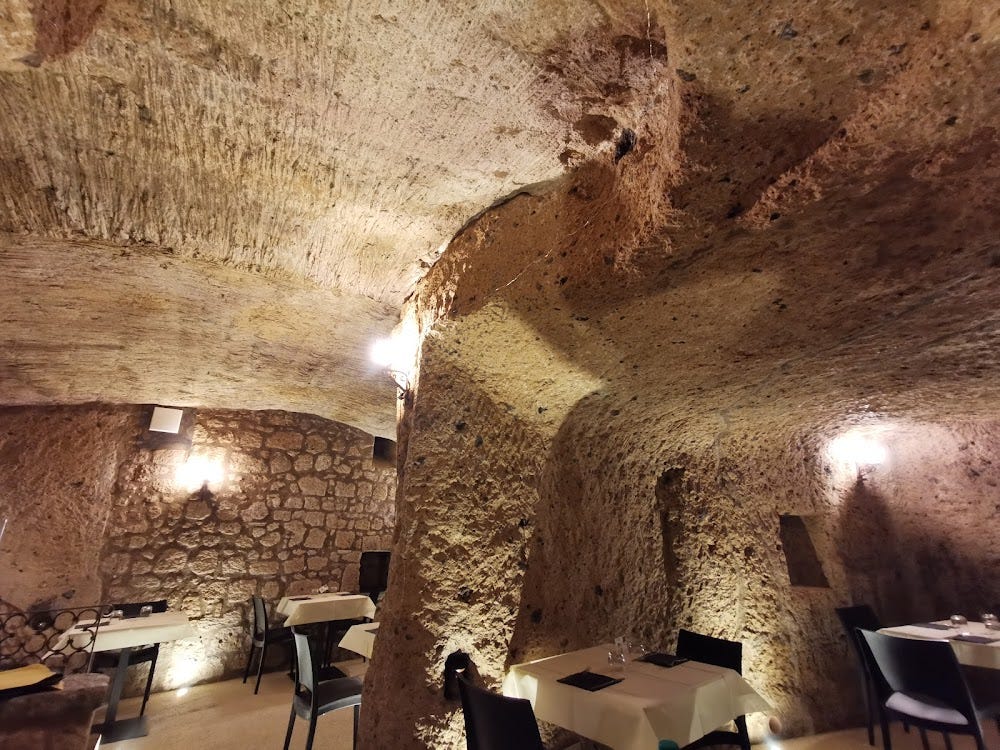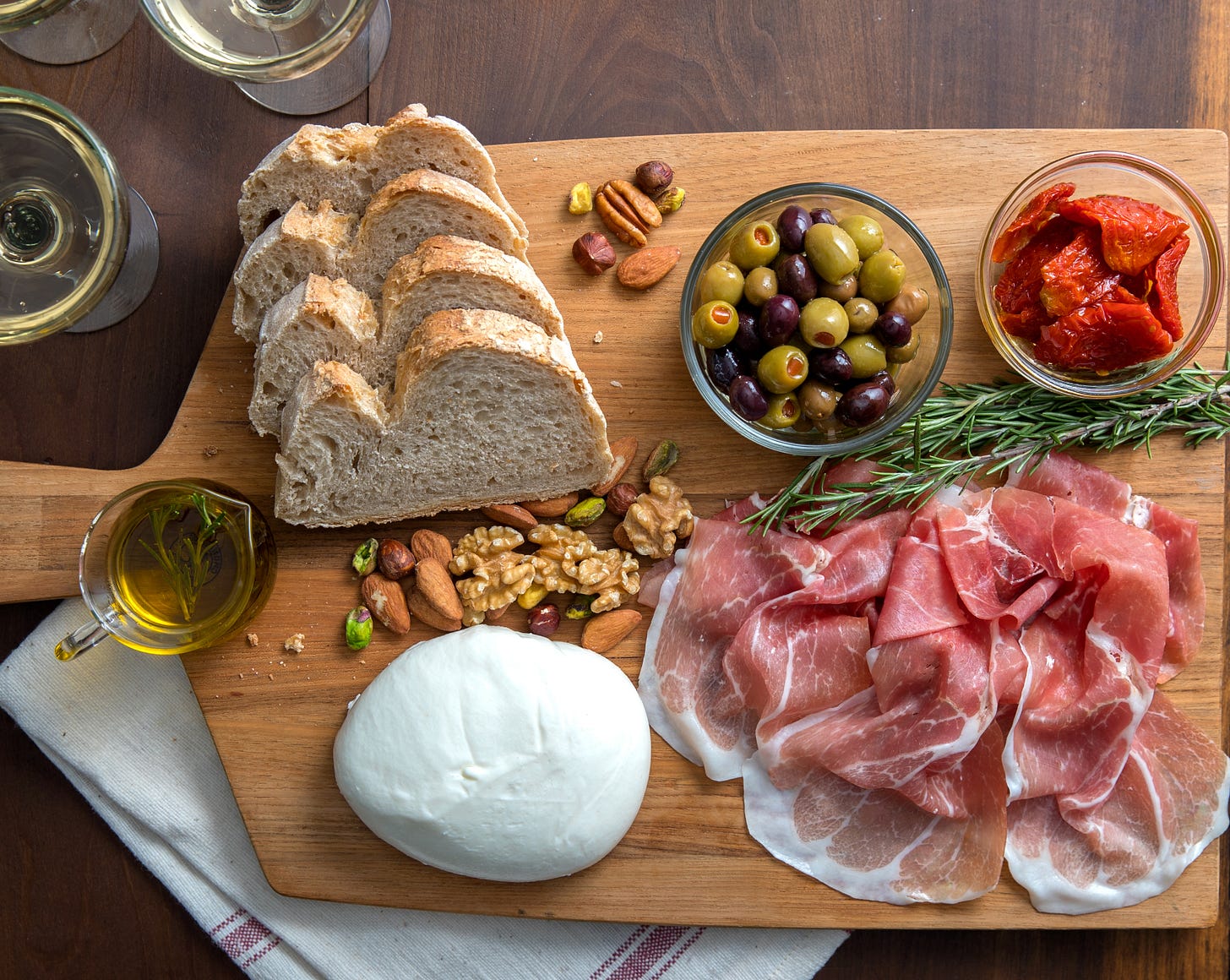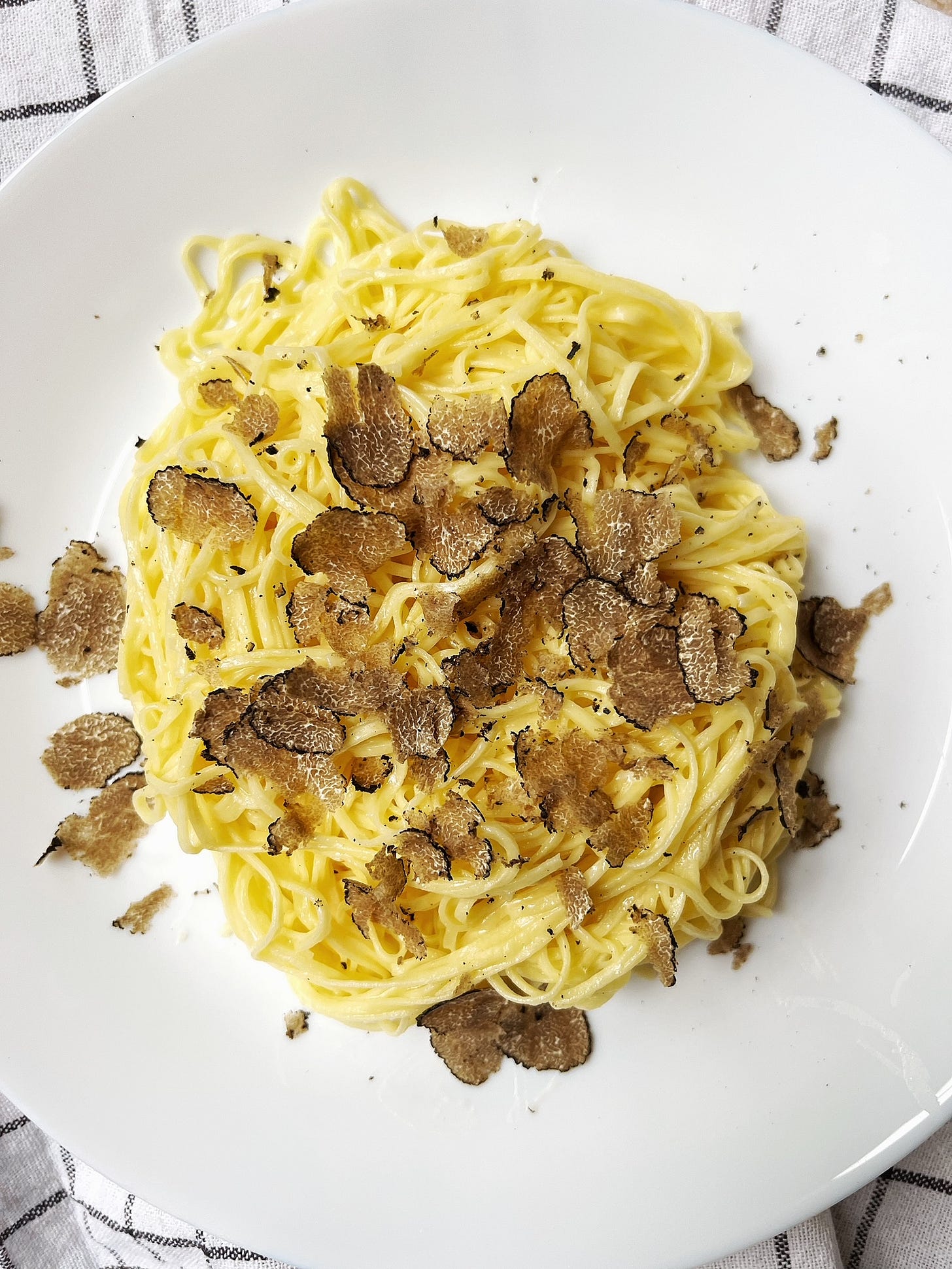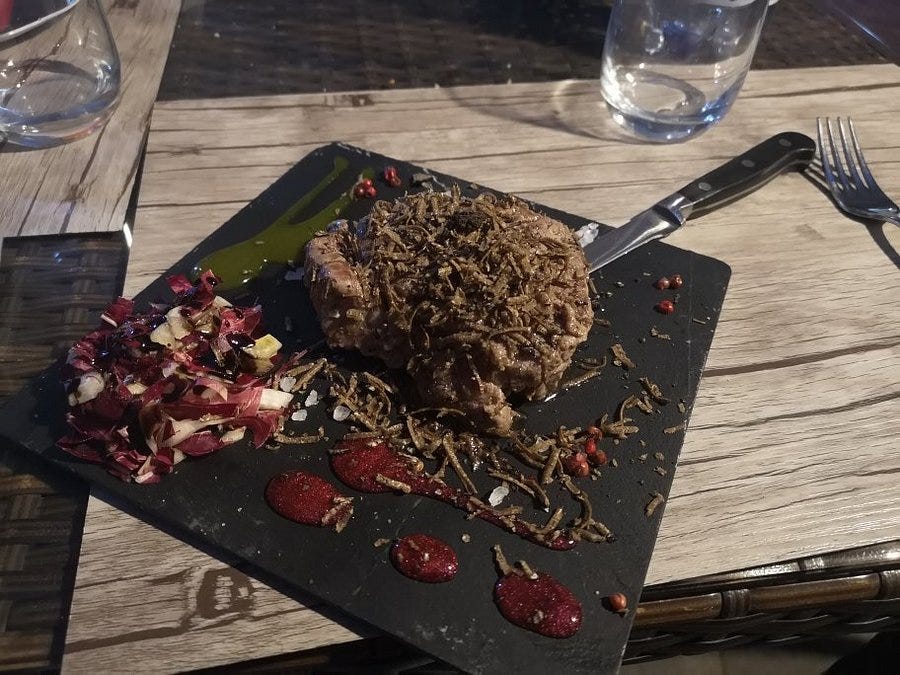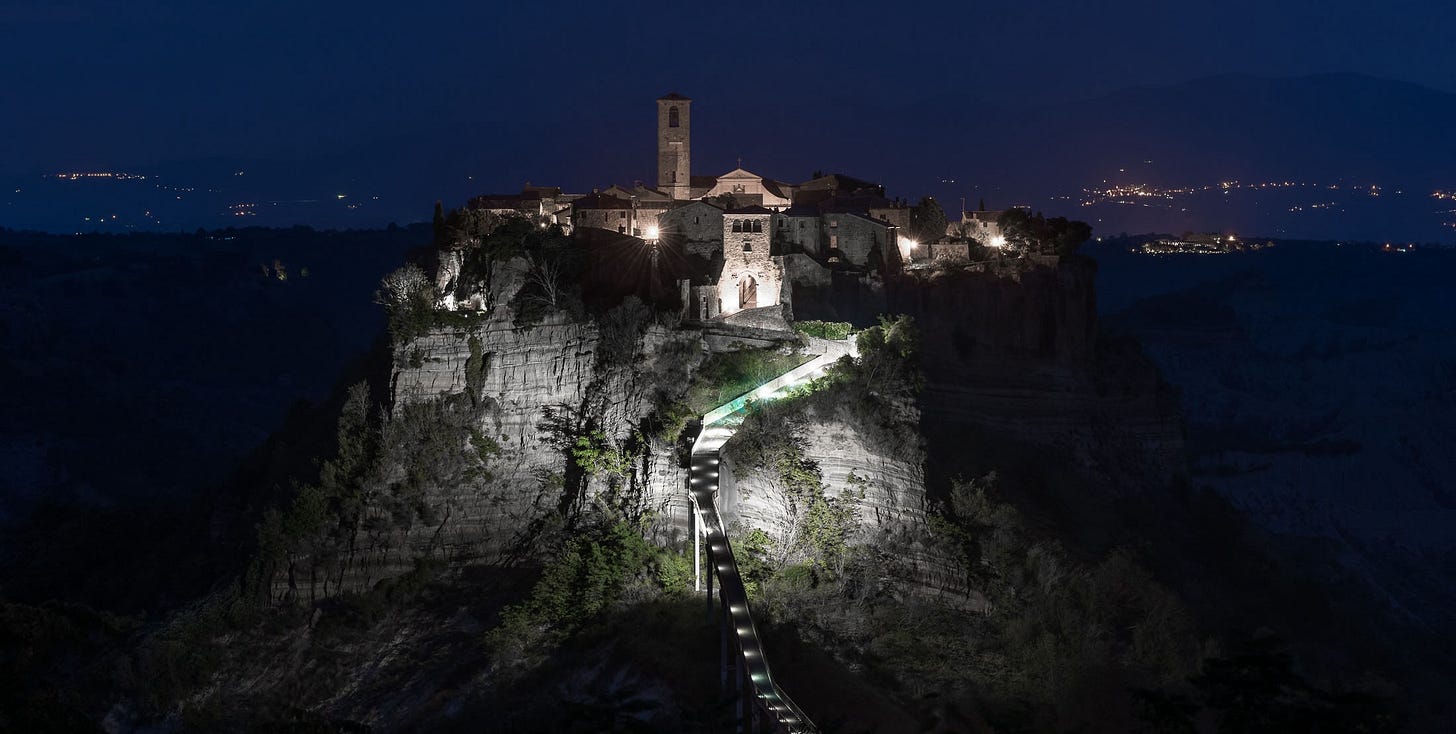Civita di Bagnoregio. The Ultimate Hill Town In Italy. A place So Picturesque It Made Your Eyes Hurt.
The road ahead stretched into the darkness, but my heart was full, warmed by the glow of an unforgettable day in an enchanting Italian village that time forgot.
The sun pushed its way into the late afternoon, drawing long shadows out across the landscape. It draped itself lazily over the Tuscan hills in Italy, massaging the terrain as I pulled on the throttle and gunned my red Vespa along the winding SP6. The engine's purr was constant, humming along and echoed around me as I attempted to push this classic piece of Italian engineering to its limits. It was a mechanical heartbeat, vibrating, trembling and constant, and it was completely in sync with my own racing pulse as I took one turn, and then another, and then another. I was excitedly headed to Civita di Bagnoregio, which was known as the ultimate hill town in Italy. A place that was so fucking picturesque it made your eyes hurt. Famously known as "the dying city”, it’s become somewhat of a tourist destination, catering to those that wish to capture a picture-perfect moment of Italian soul and perhaps witness some history along the way.
I leaned into each curve, the warm air whipping past my face in a steady flow of pressure. It carried the Italian country side as it blew between the rolling hills; an intoxicating scent of wild herbs and sun-baked earth—the smell of Italy. This was a ride into the past. It was a pilgrimage into history. It was a journey to break bread with a fellow chef, and spend time with a good friend. The road twisted and turned, each bend revealed yet another postcard-worthy vista. Rolling hills, dotted with cypress trees standing like sentinels guarding the secrets of this ancient country. They blew past me in a blur of green and gold, layers of time always present, but ever changing.
I approached Civita as the late afternoon light painted the sky in hues of orange and pink as it massaged the clouds and poked through crevasses to reach the ground. It was as if some celestial chef had decided to whip up a cosmic dessert just for this moment, and to celebrate the journey here. The town of Civita seemed to float above the valley, perched precariously on its eroding throne of volcanic rock. It was a miracle this place was still standing. Somehow, I wondering if the Pope had something to do with its survival and if there was a daily prayer said somewhere deep within the depths of the Vatican to keep this jewel standing, alive, prevalent and hopeful. I pulled into the Parcheggio Via Mercatello, killing the engine and letting the sudden silence wash over me. The transition from the thrum of the Vespa to the whisper of the wind was almost jarring. It was like waking from a fever dream to find yourself in a calming and relaxing paradise.
I looked up, taking a deep breath and took in every detail of the stunning vista in front of me. I paid the entrance fee to go in, turned and began the slow and meandering ascent to the ancient village that time seemed to clasp as tightly as ever and refused to let go. Each step that I took was a journey through history. The weight of the past pressed down on the ground beneath my feet. I hadn’t had anything to eat since I set off in the late morning. Although, I did press out a cappuccino and had a day-old cornetto that I wrapped and stored in the pantry knowing I would be rushing off this morning. And, while this might be a typical Italian breakfast, I did need something just a bit more to keep from passing out. My ride here, combined with the climb to Civita created a heady cocktail of endorphins and hunger that definitely needed my attention sooner than later. As I approached the city's entrance, Marcello waited patiently for me to arrive, a grin splitting his weathered face and his hand was outstretched already waiting to grasp a hold of mine. We embraced like long-lost brothers, separated by oceans of sauce and mountains of mise en place. The kitchen timers were previously set for this meeting, and we could almost hear them buzzing, going off at this very moment. His calloused hands patted me roughly across my shoulders with love that spoke of a lifetime in the kitchen, each scar and burn a badge of honor in our shared culinary brotherhood.
We strolled with no purpose, laughed and caught up as we turned and set off down Via S. Maria del Cassero. As we meandered slowly, our footsteps echoed off walls that had stood around us for centuries. Marcello was always the walking encyclopedia, reciting facts and dates as he suddenly transformed into my person tour guide. He gave me some of the history of this region, describing in detail, Civita's Etruscan origins, as he painted a picture of a town that had stood around a whirlwind of change that had seen empires rise and fall, families come and go, and yet still stood defiantly against the ravages of time, and the footsteps of tourists that remained constant with the ebb and flow of the seasons. Marcello spoke of the town's slow death as its residents left this little hamlet due to the constant threat of erosion and collapse. The streets that once bustled with the life of a small town in the Italian countryside, suddenly stood empty, except for the occasional tourist or service worker that might have ambled down this small yet beautiful slice of a picturesque Italian life. But even in dying, the town still clung to life as it began a slow and gradual turn around. There was a new generation slowly, carefully, trickling back, drawn to this magical and almost unbelievable place. People who wanted to preserve Civita from disappearing came armed with fresh ideas and a determination to breathe life back into her ancient stones.
We rounded a corner onto Piazza S. Pietro, the sunlight casting long shadows across the square as it started its slow decent into evening. We decided to rest for a moment and grab a glass of wine from the WineBar d'Andrea. It was as though we read each other's minds. With one look at one another Marcello and I seemed to have the same idea and walked over to an outside table in the shade to seek refuge from the heat of the day. We settled in our seats and leaned back against the stone building, ordering glasses of Bianchi Orvieto Classico Superiore with the casual ease of men who knew their way around a wine list. The bartender brought both of us a glass that was already coated with sweat, the chilled Bianchi elixir clearly opposing the humid air around it. We sipped slowly, enjoying the cold, winemaker’s concoction and letting it effortlessly cool us down and quench at least some of our thirst. The wine was crisp and bright, and completely refreshing. I smiled broadly as I wiped the sweat off of my neck slowly, Marcello laughing at my inability to tolerate heat of any kind. He wasn’t wrong. Last year in Miami, I nearly had a conniption over the intense heat and humidity that left us drenched in the middle of a wine pairing event. But, this time, I was too busy to notice his poking and mocking of my desire for cooler temperatures. At the moment, I was enjoying the notes of citrus and stone fruit dancing across my palate too much to pay any attention, and probably forgot about the whole Miami heat intolerance in the first place. Or maybe, I didn’t.
We sat at our table with no agenda. No place to rush off too. It was a typical Italian evening. Slow. Not rushed. Unhurried. Leisurely. Deliberate. And it was ultimately sublime. We watched the parade of tourists as they walked by, their faces a mix of wonder and exhaustion as they made their way this way and that way in front of us. They moved through the square like schools of fish, guided by the currents of their guidebooks, their Instagram feeds, or their TicTok recommendations. Occasionally, a tour guide would lead their group to a stopping point, to go through a piece of history, a point of interest, while the tour group stopped and took pictures, snapped selfies or reviewed their own guide books. There were a plethora of languages that drifted towards us, but we were lost in our own silent moment. We nursed our wine, we made occasional comments, and we simply lost ourselves in the slice of life and in the enjoyment of the moment.
The sun dipped lower, painting the sky in deeper shades of red and purple as the heat from the day slowly began to ease. We drained our glasses, the last drops of wine clinging stubbornly to the bottom. With a nod to each other that was seemingly silent, but fully understood, we stood, our bodies protesting slightly after the respite, and made our way up Via Madonna della Maestrà, stopping briefly to admire the Chiesa di San Donato. This beautiful, ancient church known as The Church of St Donano, was built in the year 600. We stood in awe, marveling at the old building and amazed that it still retained its Romanesque-style look despite the eastern wall, the altar, the crypt and two choirs being demolished once in 1511 and again being damaged seriously by an earthquake in 1695. Marcello dove into his historic knowledge and explained to me that the original building was remodeled which was what gave it a “Renaissance-style” look. He explained that in 1699, the seat of the diocese was shifted to the nearby village of Bagnoregio and that there was a wooden crucifix inside the church that dated back to the 1400s and a fresco of the Perugino tradition. The church appeared to just be suspended in time, much like Civita di Bagnoregio itself. It was just one of those places that made you feel so small against the backdrop of a long and rich history of a place. There was so much history embedded within the layers its stones. It’s a place where the whispers of the past mingled with the quiet hum of the present, and created a melody that resonated with anyone who took the time to stop, and to really listen.
We retraced our steps, winding our way back through the labyrinthine streets of Civita. The town seemed different now, somewhat shrouded in the gathering twilight. Shadows lengthened, giving familiar landmarks an air of mystery. Tourist had mostly cleared out, leaving only those who were staying for dinner at one of several open and delicious small restaurants, or those that wanted to finish off an evening stroll to watch night fall across a calmer slice of Italy. As we continued to slowly stroll through the town that had slowly emptied, Marcello pointed out architectural details I would have missed on my own. A carved lintel here, a faded fresco there. Each element told a story, a fragment of a larger narrative written in stone and mortar. We strolled past the Museum Antica Civitas located in within a historic residence and offered visitors insights into the history and culture of the region. We meandered past the Giardino del Poeta which was a hidden garden located just at the edge of town offered a tranquil retreat with beautiful views for those that took the time to rest, relax and enjoy the moment. We paused as Marcello pointed out the remains of the birthplace of San Bonaventura di Bagnoregio, explaining that this was the location of the remnants of the birthplace of Saint Bonaventura, which added another layer to the historical significance of this charming village. And finally, beyond all of the attractions and points of interest, there was the hamlet itself. The medieval alleys and streets that we took the time to stroll down. The hidden courtyards and shops that we wandered through. The narrow, winding pathways that time seemed to completely forget. And the hours that ticked by slowly as we fully immersed ourselves in the village's unescapable medieval charm.
The setting sun had now spilled over the edge of the horizon as it painted the sky in a watercolor wash of colors that I could only describe as mesmerizing. Long shadows appeared to stretch into endless pillars across the ancient stone walls of Civita di Bagnoregio. Marcello and I made our way slowly through the tiny winding streets on our way to dinner along Piazza S. Donata. Many of the tourists and tour groups departed for the day making the city seem stark, empty, quiet, solitary. Il Pozzo dei Desideri appeared before us, its warm light spilling out onto the cobblestones like a welcoming embrace. As we approached, the scent of garlic and herbs wafted through the air and were a siren song to my growling stomach. I peered over at Marcello, who I noticed was, like me, was nearly inhaling the air for every potential scent of culinary indulgence that we could take in. We approached the entrance fulled by that familiar tingle of anticipation and hunger. The wine that we enjoyed at WineBar d'Andrea, on an empty stomach was both intoxicating and only exacerbated the need for some real sustenance if I had any hope of hopping back on my Vespa for the trip home this evening.
Marcello and I pushed the door open with excitement and a bit of childish antics as we descending the steep, worn steps into Il Pozzo dei Desideri. The day-trippers had long since departed. The tourist groups all cleared out. It left the "dying city" to breathe a collective sigh of relief, its narrow alleys now silent, except for the occasional echo of our footsteps of those who decided to stay to experience dinner in this ancient place. The restaurant seemed to be carved into the very bedrock of this impossibly perched town. It beckoned us to descend deeper into its depths, with the promise of a meal that would linger in our memories long after the last bite. The cavernous interior of Il Pozzo dei Desideri enveloped us in its cool, damp embrace as we were led to our table by our host. Candlelight flickered against the rough-hewn walls, casting dancing shadows that seemed to whisper to us and beckons us to stay, to linger and to build a memory or two. This restaurant, once a well that sustained life of countless generations in this hamlet, now served to satisfy a different kind of hunger – one for connection, for history, for flavors that spoke of the culture, the people and their connection to this land and its family recipes.
We settled into our seats as our waiter presented us with the secrets of their own cucina. Instantly, before I even had the chance to pick up my menu, before I even had a chance to glance at its written culinary indulgence, Marcello blurted out a request for the antipasti. He was after all Italian. And, being Italian, he always started every meal with some type of cured pig and aged cheese product. A tradition that I not only agreed with but fully supported as well. The charcuterie board, also known as the antipasti, arrived like a work of art, a canvas painted with the vibrant hues of green, white and red. Which coincidentally, were also the colors of the Italian flag for those not in the know. Layered generously along the edge of the board, was Prosciutto di Parma. It was sliced so thin it was nearly translucent, each piece melted on our tongues in a symphony of salt, fat, and time. This was patient craftsmanship. Each bite, a testament to the dedication of the maestro salatore, the salt master who expertly tended to these legs of succulent pork. The sweet, nutty flavor of the prosciutto seemed to nearly envelop our entire palate as we attempted to savor our experience. Note, we did try really hard to make the experience last, but our hunger and maybe, just maybe, the overwhelming yumminess of the piggy, just couldn’t keep us from devouring the entire plate like hungry children.
We did manage to save some of the prosciutto to pair expertly with our wine selection for the evening. To note, we selected a bottle of Banfi Brunello di Montalcino for its deep ruby color, its enchanting aromatics, and its robust and deep flavors that would match the prosciutto at every bite. Our server poured the deep ruby liquid into our glasses as the wine gently caught the candlelight like liquid garnets. Our server also decanted the wine with practiced grace. As he poured, the aroma of a complex bouquet of black cherry, licorice, and hints of tobacco filled the air and promised a transcendent experience. Thankfully, we seemed to be the only ones seated in the room, because the aroma was so rich, it would have made patrons at the other end of the dining room turn their heads and inhale deeply with desire and longing. Every sommelier will always tell you—swirl, sip and then savor. However, the first sip of the Brunello was an explosion. It was as though we completely skipped the part about the swirling. Its velvety tannins caressed our palates as the wine clung to the inside of the glass in deep, rich strokes. Notes of ripe fruit and spice unfolded in layers of complexity as we each held the wines on our tongues and stared at one another like dumbfounded idiots. This wine was pure Italian history, wrapped in the expertise of generations of winemaking in the region.
Our server brought our primi piatti, sliding the plates in front of us. This dish was so rich, so fragrant, that we practically smelled the dish all the way from the kitchen. We could feel the aroma of the truffles wash over us as they were being prepped and shaved onto our plates. The tagliolini al tartufo was a dish that elevated pasta to new heights of decadence and indulgence. Generous shaved slices of black truffle were expertly layered over the steaming plates that sat in front of us and threatened to pull our noses ever downward. The sublime, earthy aroma mingled with the rich scent of the ingredients and the overpowering wine in our glasses. It was a melange of debauchery, each twisted forkful a perfect balance of silky egg sauce, al dente pasta, all elevated by the intoxicating perfume of truffle that clung to the stone walls around us. We twirled our forks, the flavors dancing in perfect harmony with the Brunello. The wine's acidity easily cut through the richness of the dish, its fruit notes a complement to the earthy truffle. It was a pairing of terroir. A deep connection between food, wine, and the land. It was blend of skill, patience, love, and centuries of culinary tradition.
While Marcello was excited for the final dish, I nearly regretted agreeing to the secondi piatti. I felt full, but when it arrived, the filetto di manzo con tartufo – beef fillet with truffle – was placed before us like a challenge, daring us to find room for its succulence. The meat, cooked to a perfect medium-rare, glistened in the low light, its surface adorned with yet more shavings of dark truffle. The simple aroma of the dish felt like it instantly made room in my stomach. The first bite was heavenly – tender beef that yielded to the slightest pressure of the knife, nearly spilling onto the plate as we sliced through it. The rich flavors were amplified by the earthy intensity of the truffle. We sliced into it deeply and savored the rich beef, as the glasses of the Brunello continued to evolve, revealing new layers and discoveries with every sip. The wine’s structure stood up beautifully to the robust flavors of the dish, the tannins finding their perfect foil in the protein of the meat. The pairing was a perfect example of the art of Italian cuisine. It was the simple ingredients that were treated with respect and expertly combined with an understanding that borders on pure alchemy.
Our meal was unhurried, as all great Italian dinners are. We lingered over the last bites, reluctant to break the spell that had settled over our table from the moment that we sat down. Our conversation flowed. The wine was poured. Our plates were emptied and taken away. Our glasses were filled and refilled. We touched on memories. We shared our dreams and revisited past hopes. These were the ineffable magic of moments of a meal in Italy, with a friend, and the unhurried desire to go no where at all. Wrapped in the cocoon of Il Pozzo dei Desideri, time seemed to stand still, or perhaps it just moved in a different rhythm altogether while we were here. Present and in the moment.
We emerged from the restaurant moving a bit slower than we did before we came for dinner. I blame the amount of food. The night air had cooled down the town, but the stone walls and cobblestone streets still felt warm to the touch. Civita di Bagnoregio was quiet. The empty streets were bathed in a silvery moonlight. The small hamlet held a different kind of beauty than it had in the bustling day. We walked slowly as our footsteps echoed off the ancient stones, and savored the quiet and the friendship. As it always seems to do, our farewells always come too soon, far too quickly even though we always know that all of these evenings must end eventually. Marcello and I embraced with promises of “Al presto! Alla prossima!” that held all the weight of true friendship. As I made my way back to my waiting Vespa, the taste of truffles and wine still lingered in my nose and on my tongue. Truffles were so rich, they always had a way of just staying with you, long after the meal was done. I inserted the key and twisted it to the “On” position. I straightened the bike, raised the kickstand, held the brake and pressed on the ignition, as my Vespa's engine purred to life. I took off, winding my way down the twisting road as the lights of Civita di Bagnoregio receded in my rearview mirror. The road ahead stretched into the darkness, but my heart was full. Full of friendship. Full of warmth. Definitely full from the amazing dinner. And full of an incredible experience, warmed by the glow of an unforgettable day in an enchanting Italian village that time forgot, if only for a moment.

